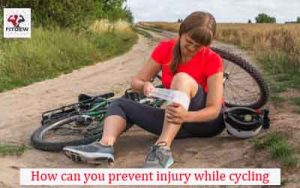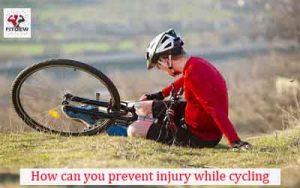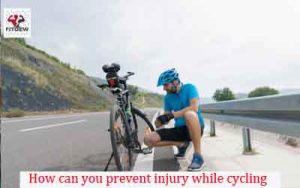How can you prevent injury while cycling?
Do you know one can get injured while cycling? Sure, it happens especially if you are just getting started with riding a bicycle. As a beginner in cycling, you are more scared most of the time and can easily get injured because you are not yet skilled in cycling.
In this content, you will learn how you can prevent injury while cycling. Read till the end of the content to get all the information you need so you can enjoy your cycle as well as avoid possible things that can result in injury while you cycle.

How can you prevent injury while cycling
How can you prevent injury while cycling?
Aside being a cheap as well as convenient type of transportation that has a very low environmental impact, cycling is also a physical activity which is enjoyable for people of all ages and can enhance your physical and mental health.
Pedaling is a low-impact activity that enhances the muscle tone without stressing your knee and ankle joints. Cycling is specifically good for cardiovascular fitness that is to say it reduces risk of heart attack and stroke. In as much as there are benefits gotten from cycling, injuries can as well occur both as a direct result of cycling and in accidents.
Now let’s discuss about how you can prevent injury while cycling.
Rules you can follow to avoid Cycling Injury Risk
- Obey road rules when cycling: If you must avoid getting injured while cycling, then you will have to strictly obey road rules while cycling. When you engage in cycling with strictly following the road rules, it enhances your safety as well as the safety of other road users.
So, follow these road rules strictly
- Don’t ride on the wrong side of the road or coast through red lights.
- Flag your intention to turn by hand signaling.
- When you are to turn right, perform a hook turn from the left side of the road.
- Ride in a way that is predictable, about one meter out from parked cars.
- Ride in single file in heavy traffic (though cyclists are allowed to ride two abreast).
- When you are cycling on shared paths or rail trails where people are walking, ensure to alert them making use of your bicycle bell.
- When riding two-abreast, ensure both riders are no more than 1.5 meters apart.
- Don’t ride two abreast on multi-lane roads.
- If practical, you must always make use of a bike line if one is available in the direction you are travelling.
- You cannot ride on urban freeways. Though some rural freeways do allow bicycle riding. Ensure you look for and obey signage.
- Maximize your visibility on a bike: Another way you can prevent injury while cycling is by ensuring you are visible enough while you are cycling. Here are some things you will need to do to ensure your visibility while cycling.
- Wear brightly coloured clothing because if you are wearing a dark coloured or dull clothing, it becomes difficult for motorists to see you while you are cycling.
- Ensure that lights are fitted to your bike, front and back for riding in all conditions. With lights on your bike, you get to be seen from afar and this will make other road users especially motorists know someone is coming from your direction on a bike.
- Garments that are reflective including reflectors fitted to the back of your shoes, will enhance your visibility at night.

How can you prevent injury while cycling
Tips on how you can reduce the risk of injury while cycling
- Assume that car drivers have not seen you and ensure you make eye contact with car drivers when you are negotiating turns or intersections.
- Braking smoothly: One of the common causes of cycling injury is hard braking because this can cause the brake to lock and can result to the rider falling over the handlebars.
Children need to be carefully instructed on how they can apply the brake safely. You use your back brakes in combination with your front brakes to minimize your weight going forward over the handlebars.
- Another way you can reduce the risk of injury while cycling is by not wearing headphones while cycling. You need to hear what is going on around you, so when you don’t use headphones while cycling you get to hear what is happening around you well.
- To reduce cycling injuries, you will ensure a professional in charge of repairing bicycles gets to service your bicycle very well at least once a year.
- You also need to check your bike regularly. At least once every week if you make use of the bicycle frequently to ensure it is still in good working condition. Check the tyres, bearings, gears, nuts and bolts, as well as lubricate the chain and cables. If you can’t do the check on your own, you can inquire from your local bike shop.

How can you prevent injury while cycling
Prevention of cycling injuries
When you don’t ride your bicycle in the correct posture as well as demanding too much of your body can result to different cycling-related injuries.
Now let’s check out some of those cycling injuries and how to prevent them from occurring.
- Cycling and lower back pain: The back is a weak link for so many riders. Bicycle riders mostly develop strong leg muscles, but don’t always have the torso strength to support as well as resist the force from the legs. This can result to your back working too hard and spasm, causing your getting tired so fast.
To prevent the lower back pain, get into the habit of keeping your back straight, both when you are riding or you are standing. With this, the back pain will reduce and it will as well enhance riding.
- Cycling and numb toes: Numbness or burning feet happens as a result of nerves being squashed. Using tight shoes, road vibration or too much climbing that puts continuous pressure on the feet are usually the causes of this.
For you to prevent or reduce numb toes you will need to the following:
- Adjust your shoes, or the straps or cleats on your cycling shoe.
- Ensure your feet are straight when you clip into the pedals (if you use cleats).
- Remove any irregular seams, straps or buckles from your shoe that may press against your foot.
- Cycling and hand injuries: The earliest sign that shows one has a hand injury is tingling or numbness in the palm or fingers.
To prevent or reduce hand injuries you can do the following:
- Ensure you observe how you are gripping the handlebars. Let the grip be firm and also relaxed.
- Frequently change hand positions.
- Don’t forget to keep your wrist straight.
- You can try out the use of padded gloves or handlebar tape to decrease the vibration.
Since children of 10 years or younger are at risk of trapping their fingers in the moving parts of a bicycle like the chain, they should be warned about these hazards. You can as well buy your child the type of bicycle that has a chain guard to protect them from mistakenly getting their hands trapped in the chain.
- Cycling and shoulder pain: Shoulder injuries mostly happen during longer rides and is mainly as a result of much weight being placed on the hands and riding with straight elbows.
To prevent or remedy shoulder pain, you need to keep the elbows slightly flexed to stop road shock transferring to the arms and upper body.
- Cycling and knee injuries: Knee injuries happens as a result of overuse and this occurs when a cyclist rides too much or too fast.
To prevent or remedy knee injuries you can do the following:
- Gradually build up your strength through training in order to minimize the strain on the knees, as well as decrease the amount of hard training or hill work.
- Switch to lower gears when you can because when you pedal for long in high gear it results to stress to your knee joints.
- Adjust your saddle’s height so you have almost straightened your knee with the ball of your foot over the pedal axle at its lowest position because if your saddle is too high or too low, stress is placed on the knees.
You can as well seek the advice of a professional bike fitter in order for you to ascertain the right height for your saddle.
The General cycling health and safety tips
- Make sure someone gets to know of the route you intend to follow as well as the time you think you will be back.
- Ensure to wear sunscreen on skin not covered by clothing.
- Take a drink with you to decrease the chance of getting dehydrated.
- In case of emergency situation, you can pack identification, money and a mobile phone.
- General comfort is crucial because it allows you to concentrate on the road. Ensure your saddle is comfortable.
You can wear cycling shorts on longer rides, as they decrease the chances of experiencing skin irritation because the material doesn’t bunch and rub against your skin.
- Ensure your bicycle is right for your height, weight as well as other needs. Ask staff at your bike shop for assistance when selecting a new bicycle so you can get the one that suits you.
Conclusion
If you can strictly follow all of the rules outlined here while cycling as well as strict adherence to the prevention tips you will sure prevent injuries while cycling.
So, when you enjoy your cycling, do it with caution and consider your body as well. Don’t overuse your body. If you notice your body need rest, you rest and continue with your cycling later.
Always remember to consider the safety of your children when purchasing a bicycle for them and as well ensure you give them the right instructions that will make them understand the need for carefulness when cycling. If you need help on any issues relating to cycling injuries you can contact your doctor.
Editor’s pick
Pros and Cons of Trampoline Exercise
10 Best Gym Exercises for Stress Relief and Relaxation (A must read for everyone)